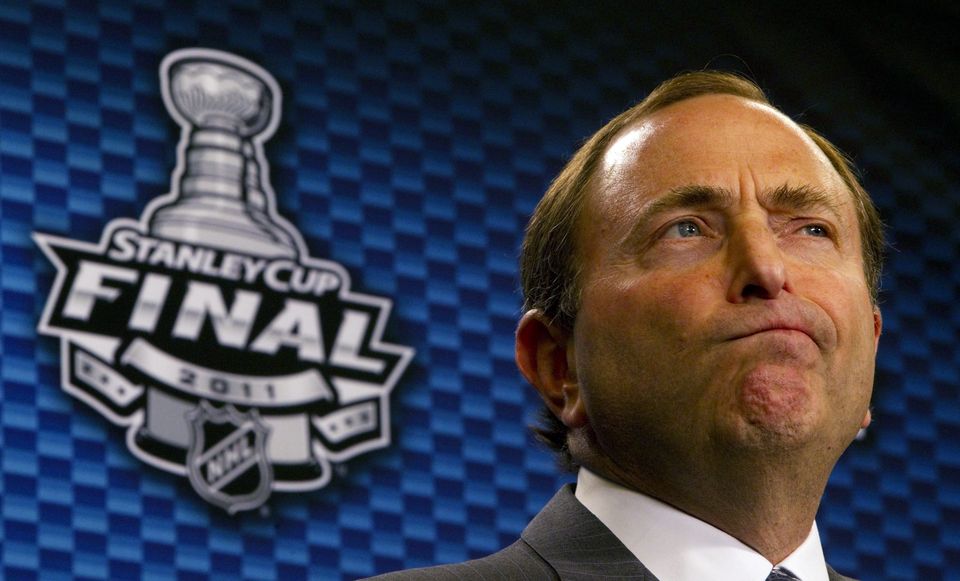How will it happen & what does it mean for the Toronto Maple Leafs?
A. Background
In a memo released in September of this year, the Chief Operating Officer of the NHL notified all league employees of initiatives and staff changes to take effect during the 2013-2014 season. In the memo the league identified a plan to increase annual gross national revenue by $1 billion dollars by the end of three years, or in other words, in time for the 2016-2017 season. To put that type of increase in perspective, it had previously taken the league from 2005-06 to 2011-12 – or 6 years – to attain the same revenue growth. Forget linear growth, we’re talking exponential revenue growth here, folks.
The memo also outlined the league’s plans for how it will go about achieving the $1 billion dollars of revenue growth, and cited 4 key areas that will drive up national gross revenue, these areas are:
- Expansion of the league’s core businesses: media, licensing and sponsorship;
- An increased focus on “big events”, which includes 6 outdoor games during the 2013-2014 season;
- An increased presence in Europe, with more NHL games being played overseas, the return of the World Cup of Hockey, and a plan for a Champions Cup competition between top European and NHL clubs; and
- Securing a new Canadian media rights deal, to begin in 2014-2015.
If that last one sounds familiar, it’s because the NHL triumphantly ticked off box number 4 when it secured an historic $5.2 billion exclusive national media deal with Rogers.
Ok, so the NHL stands to make a whole lot more money, but what exactly does this mean to your average fan – and more importantly – your average Leafs fan?
First some technical background – if this part isn’t your cup of tea, please feel free to skip to the last section – if it is your thing then all aboard the CBA train.
B. HRR and the Salary Cap
By now we’ve all become acquainted with the term Hockey Related Revenue (or “HRR”), and generally speaking it’s fairly self-explanatory, but in case you’re having trouble falling asleep at night and hot milk has ceased to do the trick, the definition can be found in Article 50.1 of the CBA, which is available here.
“Hockey Related Revenues.” “Hockey Related Revenues” or “HRR” for each League Year means the operating revenue, including Barter (as defined), from all sources, whether known or unknown, whether now in existence or created in the future, as expressly set forth in this Section 50.1(a), of each Club or the League, for or with respect to that League Year, as expressly set forth in this Section 50.1(a), on an accrual basis, derived or earned from, relating to or arising directly or indirectly out of the playing of NHL hockey games or NHL related events in which current NHL Players participate or in which current NHL Players’ names and likenesses are used, by each such Club or the League, or attributable directly to the Club or the League from a Club Affiliated Entity or League, as expressly set-forth herein, and is subject to any inclusions or exclusions as expressly set forth in the Article 50.
All of which is a fancy legal way of saying that revenues derived directly or indirectly from the blood, sweat, and tears of current NHL Players will count toward HRR. Not surprisingly, Articles 50.1(i)(C) and 50.1(i)(D) incorporate special games (like the 6 occurring during the 2013-2014 season) and national digital broadcast deals (like the Rogers deal), respectively, into HRR as these are clearly revenue streams derived from current NHL Players.
Now, let’s consider for a moment what the Rogers Deal and the outdoor games will mean to HRR. The NHL was previously earning about $190 million a year broadcasting NHL games in Canada. Under the terms of the Rogers deal, that number will increase to $300 million in 2014-2015, and will culminate in payments of $550 million by year 12 of the deal. Add to that the $150 million upfront payment that will occur in the first two years of the deal, and we’re looking at HRR increases of $185 – $360 million per season.
On top of the Rogers deal, you can also add the six outdoor games, which each gross approximately $30 million, for a total HRR boost of $365 million dollars starting next season; even leaving aside the two other areas of strategic growth that the NHL believes will spur national revenue gains over the next three years.
So why do we care what happens with HRR?
Well, by virtue of Article 50.5 of the CBA, HRR is used to determine the salary range for NHL teams. Without boring you with too many details, the salary cap for a given season is determined by using Preliminary HRR. Preliminary HRR is the amount of HRR determined at the close of the previous regular season. From this Preliminary HRR, costs associated with pension benefits for former NHL players are deducted, leaving us with a sort of net HRR. The net HRR is then multiplied by 50% (i.e. the Player’s Share) and then divided by 30 (the number of current NHL clubs).
The figure derived from this calculation is known as the midpoint, which is then adjusted up 5% each season in order to get the midpoint used to calculate the salary cap range (this is subject to change if the NHL and NHLPA want to use a different adjustment factor). In order to get the Upper and Lower Limits of the cap, the NHL then applies a 15% range around the midpoint, such that the Upper Limit is 115% of the midpoint, while the Lower Limit is 85% of the midpoint, giving you the allowable salary range.
All of which is to say, the higher the HRR in any given season, the higher the midpoint, and the higher the cap will rise in the next season. Meaning that while the 2014-2015 season will see a moderate increase to the cap, with projections suggesting a $67.7 million Upper Limit, and $50 million Lower Limit, things are going to get really interesting starting in the 2015-2016 season and beyond when the impact of the Rogers deal on HRR will begin to be seen in the cap. In fact, these same projections indicate that the salary cap may be as high as $80 million for the $2016-2017 season at the point when the NHL has presumably achieved its goal of a $1 billion increase in national revenue, and as high as $100 million by the time the CBA expires in 2022.
Follow me so far? If so, good, if not, keep reading to see what this means for the Leafs (which is what you really wanted to know anyway).
C. The Rising Cap and Leafs Contracts
Leaving aside last off-season when the Upper Limit of the salary cap shrank from $70.2 million to $64.3 million (which was CBA mandated and which we can thank for having Mason Raymond on a $1 million contract), salaries for free agents escalate year-over-year. This is simply the economic reality of professional hockey, and generally speaking, professional sports. In 2007-2008, the average salary of an NHL player was $1.9 million; in 2013 it’s about $2.5 million. That is an increase of 32% in six seasons, one of which included a half-season lock-out.
To put that in context, the Upper Limit is projected to increase about 25% in the next 3 seasons, and 55% by the end of the CBA in 2022, which suggests that the cap is set to rise at a rate that is about fast as the recent historical rate of salary increases for NHL players.
Why am I telling you this? I’m telling you this because it means we have to think about player contracts differently. Given the (rapidly) rising salary cap, the important number in evaluating a player’s value to the team is not the player’s average cap hit as a dollar figure, but the percentage that dollar figure makes up of the Upper Limit in any given year. This amount tells us not only what the player’s value is to the team, but also the impact of the player’s salary on the team’s ability to surround him with other talented players. Let’s call this figure the player’s “Relative Compensation”.
(i) Relative Compensation
The Relative Compensation figure makes sense for a team like the Leafs because it indicates what percentage of the Upper Limit (and as a cap team, the Leafs’ will spend to the Upper Limit) the player accounts for, and how much of the Upper Limit will be left to sign other players. Based on what we know, for every year of term on a player’s contract it is safe to assume two things; first, that his Relative Compensation will decrease as a function of the rising cap, and second, that the cost of acquiring a similarly talented UFA will increase as average salaries continue to rise. That being the case, and as long as a player is performing consistently, he’s providing greater relative value in each following season.
The trick if you’re a GM trying to sign a free agent is to figure out a salary number and a term that allows the player’s Relative Compensation to be less than or equal to his level of play for as many of the contract years as possible. When a UFA is signed it’s not unlikely that his cap hit and Relative Compensation will exceed comparable players in the short-term, this is just the reality of signing a new contract, especially with UFA’s. However, as time progresses the player should become relatively more valuable than a comparable player as his Relative Compensation decreases and the cost of signing a comparable player as a free agent increases – all of which assumes that the player’s level of play has not suffered significant regression at the time of comparison.
The Relative Compensation statistic is also useful because it allows us to make historical comparisons between players who are making different salaries across a number of seasons, based on the percentage of the Upper Limit the player’s cap hit accounted for during any given season. By doing this comparison we can estimate whether the cap hit associated with a player in a current season is, relatively speaking, of equal value to a player of comparable talent in a previous season, as well as roughly estimate what a player of comparable talent should cost (in cap dollars) in the future. All of which allows us to determine whether the player being compared is providing value to his team relative to his cap hit.
(ii) Relative Compensation: David Clarkson
Let’s use the newly signed David Clarkson as an example, although this analysis could be used for any player. David Clarkson will earn $5.25 million for the next 7 seasons. Based on this season’s Upper Limit figure, his Relative Compensation is 8.2%. At 8.2% Relative Compensation in the 2013-2014 season, David Clarkson is being compensated roughly the same as Marion Hossa. Now that looks pretty high, but what will this contract look like during the 2016-2017 season, which is when Clarkson’s deal will be half completed, and when the Upper Limit is projected to reach $80 million? At that time Clarkson will be making 6.56% Relative Compensation.
For comparison’s sake, let’s look at what a player making 6.56% Relative Compensation looks like during the 2013-2014 season, which is a $4.22 million player.
NHL Forwards Currently Making Similar Relative Compensation
| Boston Bruins | Loui Eriksson | $4.25 million |
| Boston Bruins | Brad Marchand | $4.5 million |
| Buffalo Sabres | Cody Hodgson | $4.25 million |
| Buffalo Sabres | Ville Leino | $4.5 million |
| Calgary Flames | Jiri Hudler | $4 million |
| Calgary Flames | David Jones | $4 million |
| Chicago Blackhawks | Bryan Bickell | $4 million |
| Colorado Avalanche | P-A Parenteau | $4 million |
| Columbus Blue Jackets | R.J. Umberger | $4.6 million |
| Dallas Stars | Ray Whitney | $4.5 million |
| Dallas Stars | Erik Cole | $4.5 million |
| Florida Panthers | Tomas Fleischmann | $4.5 million |
| Montral Canadiens | Daniel Briere | $4 million |
| Montral Canadiens | Max Pacioretty | $4.5 million |
| Nashville Predators | Mike Fisher | $4.2 million |
| Nashville Predators | Patric Hornqvist | $4.25 million |
| Nashville Predators | David Legwand | $4.5 million |
| New York Rangers | Ryan Callahan | $4.275 million |
| Ottawa Senators | Milan Michalek | $4.333 million |
| St. Louis Blues | David Backes | $4.5 million |
| St. Louis Blues | T.J. Oshie | $4.175 million |
| St. Louis Blues | Chris Stewart | $4.15 million |
| St. Louis Blues | Derek Roy | $4 million |
| Tampa Bay Lightning | Ryan Malone | $4.5 million |
| Tampa Bay Lightning | Teddy Purcell | $4.5 million |
| Washington Capitals | Brooks Laich | $4.5 million |
| Washington Capitals | Martin Erat | $4.5 million |
| Winnipeg Jets | Olli Jokinen | $4.5 million |
| Winnipeg Jets | Andrew Ladd | $4.4 million |
| Vancouver Canucks | Alex Burrows | $4.5 million |
| Vancouver Canucks | David Booth | $4.25 million |
It would be a stretch to describe most of these players as being comparable to Hossa, but these are the types of players that 6.56% Relative Compensation buys. The question then becomes, can a 32 year old David Clarkson provide equal or better play for the Leafs in 2016-2017, than the players in this list will for their teams during the 2013-2014 season? If so, then Clarkson’s Relative Compensation in 2016-2017 will be in line with his play, and he’ll be of value to the Leafs.
If he is not outperforming the players on this list, then we also have to ask what it would cost to acquire a comparable player to a 32 year old David Clarkson as a free agent in 2016-2017. If a similar player would cost $5.25 million or more, then David Clarkson will again be providing value to the Leafs. If a comparable player would cost $5.25 million or less, then David Clarkson will not have provided value to the Leafs, and would be unlikely to ever perform to the level of his contract.
Looking at the list, are these players that David Clarkson circa 2016-2017 can outperform? Outside of Martin Erat, Daniel Briere, R.J. Umberger, Ryan Malone, Ville Leino, Ray Whitney and Erik Cole, there aren’t many candidates for Clarkson to outdo. That being the case, if David Clarkson is ever to provide value for the Leafs that is commensurate with his pay, it will have to come from increases to player salaries that outpace the rising salary cap, making 32 year old David Clarkson a relative bargain. In other words, while Clarkson may become more valuable than he is now based solely on the economics of hockey, don’t expect him to perform up to his Relative Compensation.
Now we know what to expect from David Clarkson, but what does Relative Compensation mean for another high-profile Leaf, UFA to-be, Dion Phaneuf?
(iii) Relative Compensation: Dion Phaneuf
This season Dion Phaneuf is making $6.5 million in the last year of a 6 year deal. His Relative Compensation is 10.1%. At 10.1%, Phaneuf’s Relative Compensation is not far removed from a player like Zdeno Chara – he of the Norris Trophy and Stanley Cup. So is Dion Phaneuf overpaid by a little? Probably.
Now let’s assume for the sake of argument that Phaneuf signs the $7 million times 7 year contract that Kypreos reported last month. Let’s assume also that by year 3 (the 2016-2017 season) that a 31 year old Phaneuf has not seen any significant regression in his game, which I would argue is a fair assumption given his play this season and his relative durability over his career.
In year 3, when the cap is projected to reach $80 million dollars, Phaneuf’s Relative Compensation would be 8.75%, and he’d actually be more valuable to the Leafs, relatively speaking, than he is during the 2013-2014 season despite his increased cap hit.
For comparison sake, let’s look at what Relative Compensation of 8.75%, which equates to $5.625 million this season, buys you.
NHL Defenseman Currently Making Similar Relative Compensation
| Buffalo Sabres | Tyler Myers | $5.5 million |
| Columbus Blue Jackets | James Wisniewski | $5.5 million |
| Calgary Flames | Dennis Wideman | $5.25 million |
| Dallas Stars | Sergei Gonchar | $5 million |
| Montral Canadiens | Andrei Markov | $5.75 million |
| Pheonix Coyotes | Oliver Ekman Larsson | $5.5 million |
| Pheonix Coyotes | Keith Yandle | $5.25 million |
| Philadelphia Flyers | Kimmo Timonen | $6 million |
| Philadelphia Flyers | Mark Streit | $5.25 million |
| Pittsburgh Penguins | Paul Martin | $5 million |
| San Jose Sharks | Brent Burns | $5.76 million* |
| Tampa Bay | Matt Carle | $5.5 million |
| Vancouver Canucks | Alexander Edler | $5 million |
| Washington Capitals | Mike Green | $6.08 million |
| Winnipeg Jets | Tobias Enstrom | $5.75 million |
*Brent Burns signed this contract in August, 2011 and was not converted back to forward by the Sharks until March of the following season.
Looking at this list, if Dion Phaneuf is making $7 million in 2016-2017 then his decreased Relative Compensation of 8.75% could not be expected to buy a team the equivalent of a Zdeno Chara, so Chara is no longer a fair comparable. As the list above demonstrates, with maybe a couple of exceptions, the defensemen with a Relative Compensation of 8.75% are not “stud” number one defensemen in the Chara mould, but either good-to-very good second-pairing guys, or offensive specialists with defensive limitations.
Is Dion Phaneuf a high-end second pairing defenseman? In his sleep. This is a player that plays the toughest minutes on his defensively porous team every night, yet still sits at +12. Phaneuf plays both of the special teams, is good for about 40 points a season, and wears the ‘C’ in one of the toughest media markets in the NHL. Add to that his penchant for opportune goal scoring (I count 24 game-winning goals to his NHL resume), and his ability to lay a big hit or fight, and you’ve got the makings of a very good, if not quite elite all-around defenseman. As the list above demonstrates, that description is on the positive side of what a team can expect to get for Relative Compensation of 8.75%.
What’s more, is it reasonable to expect that in 2016-2017, when the Upper Limit has reached $80 million, that a team will be able to acquire a player of 31 year old Phaneuf’s calibre and spend less than 8.75% Relative Compensation (or $7 million); especially in light of rising player salaries?
Either way that you break it down, Dion Phaneuf is likely to provide value to the Leafs at $7 million until 2018-2019 when he’ll be 33 and should be expected to decline. At that point he’ll have completed 5 of his 7 contract years, or 70% of his contract. For a free agent to provide value relative to his contract for at least 70% of his contract is actually pretty good. In order to achieve the same feat, Ryan Suter will have to be playing up to his $7.58 million dollar contract until the 2020-2021 season.
Furthermore, given that the cap is forecasted to reach $100 million by 2022, which is the year after Phaneuf’s proposed deal would end, his Relative Compensation will also continue to fall for the life of his deal, and it will not be necessary for him to play at his current level in order to provide value relative to his contract.
All of which is to say, if we can get Dion to sign on the dotted line for $7 million or less, for 7 years or less, then that’s a deal the Toronto Maple Leafs can and should live with, and we have Rogers and 6 outdoor games this season to thank for it.
Until next time,
Elliot

































